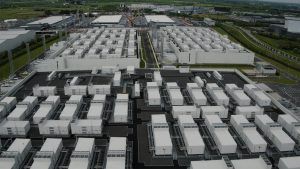Data Center Boom Turns Spain into a Digital Hub for Southern Europe

The number of data centres in Spain is exploding. And this has only just begun, as the installed capacity will increase sixfold in the next two years.
Spain is becoming a key player in the digitisation of Southern Europe. “Data centres are experiencing a historic moment in Spain, the country where the sector is growing the most in Europe,” says Manuel Giménez, executive director of Spain DC, the Spanish datacentre association.
“Madrid continues to be the privileged location for the development of data centres in Spain, representing 61% of the national offer in 2023 (147 MW IT); although Barcelona has increased its representation to 14.4% (34.9 MW IT) and Aragon has reached 37.2 MW in 2023, consolidating itself as a new technological enclave in Spain,” he explains.
According to Spain DC data, our country has 160 MW installed, with a forecast to multiply this power by six, exceeding 600 MW in 2026. This will allow us to approach the levels of the large European markets, such as Frankfurt, London, Amsterdam and Paris, which make up the so-called ‘FLAP’.
“To achieve the growth that will place Madrid among the FLAP regions, it will be necessary to intensify investment in electricity transmission networks and their effective implementation. The competitive problem for the sector is not in the availability of energy, but in the difficulty and slowness of access,” Giménez points out.
Likewise, Juan Vaamonde, country director of Data4 in Spain, considers that our country can become the main technological hub in southern Europe if it manages to “eliminate the barriers that impede development, such as access to energy and the management of administrative procedures”.
The keys to the boom
This boom in Spain has been noted for some years. “In 2018, we presented the first ‘Madrid Hub Digital’ report, which already reflected Spain’s capacity to become a digital hub, mainly due to its geographical position and its capacity for data transit through the capillarity of its network, both terrestrial, which was already deployed, and the announced arrival of submarine cables to our shores. To become a real hub, all that was needed was to deploy more data centres where this data would be interconnected,” says Robert Assink, managing director of Digital Realty in Spain.
“In 2024, taking stock of the capacity of both elements – network and data centres – that make up the interconnected infrastructures, we can state, without a doubt, that our country is the main interconnection node in Southern Europe and that, little by little, we are consolidating this position thanks to the investments that are coming to multiple locations, such as Barcelona or Madrid,” he adds.
Eulalia Flo, CEO of Equinix in Spain, highlights three aspects that explain the boom of the data centre sector in Spain. Firstly, she highlights Spain’s “strategic geographical position”, “which connects Europe and North Africa, and actively looks to the other side of the Atlantic, with a great attraction towards Latin America, due to its strong linguistic and cultural ties, and with the United States as an alternative to the congestion of the networks between the North American country and Northern Europe”.
He also recalls that “the Iberian Peninsula is a strategic connection point for submarine cables for data communications between Europe, Latin America, the United States, Africa and the Middle East, which is an incentive for the arrival of new connectivity providers”.
![]()
Finally, he points out that “Spain’s geography offers higher levels of solar radiation than other parts of Europe, which gives the country unbeatable conditions for the generation of renewable energy”.
Likewise, Enrique Ruiz, director of the Cloud Region of Microsoft Data Centres in Spain, considers that our country “is one of the great European technology hubs, with a perfect geographical location, access to renewable energy, telecommunications networks, a powerful technology industry, digital talent and a great capacity for innovation”.
“For all these reasons, Spain has established itself as one of the ideal places to invest and locate data centres from which to provide cloud and AI services to organisations across Europe,” he adds.
Google: cloud region in Madrid
The arrival of the so-called hyperscalers is just confirmation of this trend. “Google Cloud’s decision to open a cloud region in Madrid more than two years ago, the first global hyperscaler to do so, is a testament to this trend,” says Javier Martinez, head of customer engineering for Spain and Portugal at Google Cloud.
“This investment not only solves data residency issues for local businesses, but also provides a solid foundation for accelerating digital transformation across the region. The presence of this type of infrastructure reduces barriers to cloud adoption and fosters an environment conducive to technological innovation, further consolidating Spain’s position as a leading digital hub in Southern Europe,” he says.
As such, the company’s presence in Spain has taken the form of the establishment of a Google Cloud region in Madrid. “This region not only delivers high-quality, low-latency cloud services to customers in Spain, but also plays a key role in improving the capacity and resilience of our services across Europe,” says Martinez.

It is not an isolated fact, but the company has big plans for our country. “Our commitment to Spain is reinforced by a major five-year investment plan, exceeding $650 million, announced in 2021. This plan covers critical infrastructure projects such as the Madrid cloud region and the Grace Hopper submarine cable, which landed in Bilbao in September 2021 and connected Spain with the United States and the United Kingdom,” he notes.
“Beyond infrastructure, we are actively fostering local talent and expertise through initiatives such as our cybersecurity centre of excellence in Malaga. This centre provides training, fosters collaboration with companies and institutions and nurtures a growing pool of cybersecurity professionals in Spain,” he adds.
The Cloud AWS region in Aragon
The increase in demand for cloud services and the growing adoption of AI technology by Spanish companies and organisations justifies AWS’ commitment to our country.
“More than 75% of companies listed on the Iberx35 use AWS to accelerate the commercialisation of products and services, reduce costs and drive innovation. These AWS customers include major financial services companies, such as BBVA, Banco Santander and Mapfre; travel and hospitality companies, such as Meliá International Hotels, NH Hotels and Vueling; and energy companies, such as Cepsa, Endesa and Acciona, among others,” said David Blázquez, senior public policy for Infrastructure and Energy at AWS Iberia.
“In addition, Spanish public sector organisations are also using AWS to drive cost savings, accelerate innovation and provide better service to citizens, such as the Ministry of Agriculture, Fisheries and Food, the Government of Aragon, Madrid City Council and the Spanish Post Office. And educational institutions such as CEU, IE, ESIC and the Universitat Oberta de Catalunya, among others, also make use of AWS services,” he adds.
It has been a year and a half since the AWS region in Aragon started operating. “Our choice of Aragon has always been linked to the institutional trust offered by the governments we have dealt with over the years, the strength of the Aragonese business fabric and local talent, the wide availability of land and the potential of resources and sustainable sources with which we can contribute to the sustainability of our operations. And in May, we are reinforcing this commitment with a new investment, helping to place Aragon at the forefront of the technological vanguard in Spain,” says Blázquez.
“Our ‘Cloud AWS Europe (Spain)’ region can serve not only local customers in Aragon, Spain and Portugal, which due to proximity have lower latency levels, but also any company in the world that wants to host their data loads in our Aragon region,” he adds.
Microsoft Spain Central
Ruiz highlights that Microsoft’s presence in our country responds to its commitment to the development of the European digital economy. “We are one of the companies that invests the most in digital infrastructures in Europe, with Spain being one of the strategic destinations for these investments. In Spain, we are quadrupling our investments in Artificial Intelligence and Cloud infrastructure during 2024-2025, to 2.1 billion dollars. This is the largest investment the company has made in Spain in our 37 years of presence in the country,” he explains.
He also emphasises that “Spain is one of the few countries in Europe where Microsoft has projects underway for two regions”.

“We have recently announced the opening of our first cloud region in Spain, called Spain Central, located in the Community of Madrid. This strategic infrastructure is part of our commitment to invest to accelerate the digitisation of Spanish organisations, the development of AI and cloud services in Spain and to consolidate our country as a key technology hub in Europe,” he says.
He specifies that this new cloud region is among the five most important in Europe and has three interconnected availability zones, “which guarantees the high availability and continuity of the services offered through this infrastructure”. He also explains that ‘Spain Central’ “will have the most advanced capabilities in Europe in terms of generative AI, positioning Spain as a hub for innovation in this technology”.
“Spain Central is already operational and some of the clients who are already seeing benefits from it are Abanca, Aciturri, Banc Sabadell, Banco Santander, Bankinter, BBVA, CaixaBank, Canal de Isabel II, CELSA, Codere, Comunidad de Madrid, Grupo Catalana Occidente, Ibercaja, Ilunion, Metrovacesa, Mutua Madrileña, Naturgy, Navantia, Pelayo, Prosegur, Repsol, Ribera Salud, SegurCaixa Adeslas, Técnicas Reunidas, Telefónica and Velilla”, says Ruiz.
He also recalls that Microsoft has launched a ‘Strategic Partner Programme’, with the aim of accelerating the digital transformation of these organisations and supporting them in the migration of their workloads to the new data centre region. “We have the participation of ten strategic partners: Accenture, Capgemini, DXC Technology, Fujitsu, Minsait, KPMG, Kyndryl, NTT DATA, SEIDOR and Telefónica Tech,” he said.
The company has also announced its intention to build a data centre campus in Aragon, which will not only serve Spain, but also companies and organisations in Southern Europe.
Other data centre deployments
Other providers are also participating in the consolidation of the datacentre sector in our country. “At OVHcloud we recently announced the opening of a new Local Zone in Madrid, which was also the group’s first worldwide,” said Adrián González, the company’s sales director for Southern Europe.
“The new Local Zone allows our customers and partners to benefit from our public cloud solutions, enabling new use cases with the lowest possible latency and now also hosted in Spain. In this way, we respond to the growing demand to locate data in national territory for projects where there is sensitivity to the location of the data, complying, as usual, with the highest standards of security and certifications of the group”, he states.
![]()
OVHcloudEquinix, for its part, plans to inaugurate its second data centre in Barcelona in the second half of 2024, in response to the consolidation of the city as a strategic point for terrestrial and submarine cable networks. “This new facility will serve as a strategic connection point for data communications between Europe, Africa and the Middle East, and will quickly make Barcelona an essential submarine cable mooring location,” says Flo.
Data4 has also deployed 150 MW of IT power in Spain in its four and a half years of presence in the country. “We are contributing to position Spain as a European hub of reference with the construction of two new datacenters in our Alcobendas and San Agustín del Guadalix (Madrid) campuses, which will have a total IT power of 24 MW. In addition, more infrastructure is planned to be deployed in San Agustín del Guadalix, so that the new campus will eventually have more than 16,000 square metres of IT space and a total capacity of 70 MW”, he specifies.
Digital Realty also continues to grow, with a data centre under construction in Barcelona. “We are talking about a 15 MW data centre, close to the Barcelona Cable Landing Station, where the main submarine cables arrive,” says Assink.

The company’s first datacenter in Spain was set up in 2000 and currently has four operational data centres in Madrid. The last one to be inaugurated started operating in March 2023. It is MAD4, which has 30 MW of electrical power.
Huge impact on the economy
The configuration of Spain as a digital hub for Southern Europe could have a major impact on both the Spanish economy and on attracting new investment.
“Investment in digitalisation, whose main lever is the development of data centres, could add 37,834 million euros to the national GDP by 2026. In the specific case of data centres, according to the latest Spain DC report, it is estimated that in the next two years some 8,000 million euros in direct investment will arrive in our country”, Giménez points out.
Martínez also states that “the establishment of a solid digital infrastructure, such as the Google Cloud region in Madrid, attracts significant investment and stimulates economic growth”.
“We believe our Madrid region could have a positive impact for Spain, adding up to $1.5 billion to Spanish GDP growth and generating up to 13,700 new jobs by 2027. In more detail, Google Cloud’s impact on the productivity of Spanish companies represents between 1.2 and 1.3 billion euros of GDP growth and between 9,000 and 10,000 jobs by 2027. On the other hand, the impact of Google’s investments in infrastructures represents 240 million euros and 3,700 jobs,” he explains.
Ruiz also highlights the role to be played by Microsoft’s new cloud region in Spain, which will involve an investment of $2.1 billion over the period 2024-2025. “This major project, which places Spain as one of the powers in the ‘AI Economy’, will not only bring technological advances with the leading role of generative AI, but also a significant economic and employment impact. According to data presented by IDC, Spain Central will generate around €10.7 billion to the national GDP and contribute to the creation of around 77,000 jobs between 2024 and 2030,” he says.
“This is an engine of growth for our country’s economy, which is associated with strong investments by Microsoft, the creation of jobs and the generation of local business in the company’s partner ecosystem in Spain, which is made up of more than 12,600 technology companies. These companies generate 7 euros for every euro that Microsoft invoices in Spain”, he adds.
Assink also emphasises the multiplier potential of investment in data centres. “In the studies we have carried out since 2018, we have seen that, in the case of Madrid, each euro invested in data centres can multiply between 9 and 12 euros. And a month ago we presented the study ‘Barcelona Puerto Digital’, which analysed Barcelona’s capacity as a digital hub. Here the multiplier effect is 7 euros for every euro invested in digital infrastructures,” he explains.
For example, Flo specifies that Equinix’s operations “generated approximately 205 million euros in economic output and contributed around 70 million euros to the income of Spanish households”, according to a KPMG report. It also notes that the construction of its campuses in Alcobendas and L’Hospitalet de Llobregat (Barcelona) is expected to contribute around €850 million to the Spanish economy.
The challenge of the talent shortage
In addition, Vaamonde recalls that “the sector is widely recognised as an industry with jobs that require talent and innovation, where highly qualified professionals such as industrial, civil, telecommunications and computer engineers, among others, work. I believe that in Spain we have plenty of potential to train and attract professionals in all these activities and develop them in situ”.
![]()
However, if we want Spain to become this technological hub for Southern Europe, we have to face the challenge posed by the shortage of talent. “To cope with this growth, we will need a large number of qualified personnel. The association’s latest professional profiles report identified that the industry will need 2,000 professionals in more than 140 high-demand positions over the next two years,” says the executive director of Spain DC.
Blázquez also emphasises this aspect. “From AWS, not only will we support more than 17,500 full-time jobs annually until 2033 after our latest investment, but one of the company’s key focuses is training. As part of Amazon’s commitment to train more than 29 million people in cloud technologies by 2025 and more than 2 million specifically focused on AI-related technologies, we offer various training programmes for different audiences, as well as local educational initiatives in communities where we have a local presence and operate our infrastructure,” he said.
In this regard, he highlights AWS’s ‘Tech Alliance’ to combat the cloud talent shortage. “It is a coalition of governments, educational institutions and AWS customers and partners that was created to address the digital skills gap in university and vocational curricula to better prepare students for careers in technology. This partnership has several educational programmes and benefits more than 450 vocational schools and more than 70 universities”.
Another initiative in this direction is its AWS InCommunities programme. “It is implementing multiple activities in various municipalities in Aragon in areas such as education, the environment, water, biodiversity, economic momentum, community prosperity and workforce development,” he says.
Ruiz also emphasises Microsoft’s commitment to digital talent development. “We offer free training programmes on cloud and AI technologies to unemployed people and support community and environmental projects in the region. To do this, we collaborate with public administrations and educational institutions to improve the digital skills of the population and encourage the adoption of advanced technologies,” he explains.